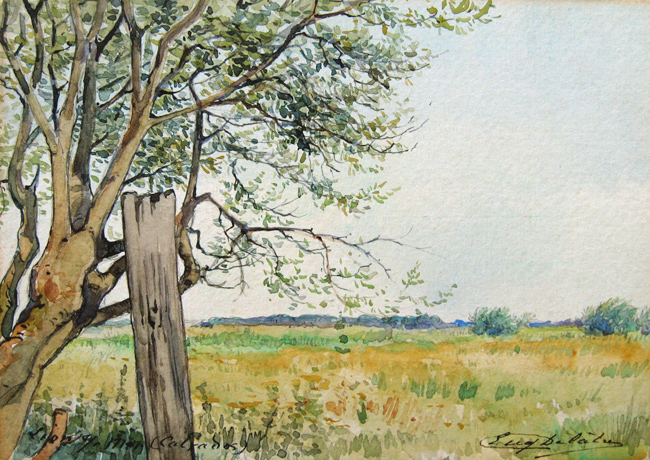EUGÈNE DELATRE PAINTINGS FOR SALE & BIOGRAPHY
EUGÈNE DELATRE
French, 1864–1938
BIOGRAPHY
The son of famous engraver Auguste Delatre, Eugène Delatre was taught engraving by his father and studied watercolor with John Lewis Brown (1829–1890). He traveled with his father to England, where they lived from 1871 to 1876. Upon their return to Paris, Eugène started working as an engraver. He became an associate of the Société Nationale des Beaux-Arts where he would exhibit every year. In addition, he took place in many exhibitions abroad and was one of the first members of the Society of Colour Engravers.
Eugène Delâtre had two teachers: one was John Lewis Brown with whom he trained a little in watercolour technique; the other was his father, the renowned engraver Auguste Delâtre, a master craftsman whose success and fame was due entirely to his own talent and passion for his art. Likewise, Eugène's success was due very largely to his own dedication. While still very young he began to practise wood engraving in his father's studio. He accompanied his father to England from 1871 to 1876 and on his return to Paris set about working as an engraver. He became an associate of the Société Nationale des Beaux-Arts and exhibited there every year. He also took part in numerous exhibitions abroad and, with Georges Petit, was one of the first members of the Société de la gravure en couleurs (Society of colour engravers).
'Eugène Delâtre was more ambitious than his father and wished to develop his own creative talent. Marc Stéfane described him as a 'poet landscapist', but Delâtre was also a skilled portraitist. He was able to capture on paper any subject that caught his eye, whether a face, a picturesque genre scene or a harmonious leafy spot. He would then take this sketch, correct, develop and improve it, transforming it into a true composition that he then engraved in copper with meticulous care and attention. Nobody else touched the work at any stage. Delâtre as a painter conceived it, as an engraver executed it and as a printer brought it to the page: he combined in one artist the three skills needed to produce a fine print. He modernized the art of colour engraving and, through a series of different processes, managed to evoke the fine plates of the master engraver Debucourt.
His method was both practical and simple. Having created a watercolour in the three basic colours of yellow, red and blue, he first produced an elaborate sketch on copper using pure acid etching, sometimes using the drypoint method and sometimes with the grain or even, though rarely, soft varnish. He used this first plate to print off the darkest tone, then, on the engraved copper, he took a black proof which he transferred to a clean copper plate. He used this second plate to produce the second etching, continuing in the same manner until he reached the lightest tones. He then produced a succession of prints, beginning with the lightest. This brief technical description cannot do justice to the charm of his use of colour and the picturesque quality of his engravings. Delâtre's prints always retain the softness of the watercolour from which they are derived. Perhaps the most interesting part of his work is that in which he reveals himself to be the artist of Montmartre, or 'Montmartrois de Montmartre' in Rodolphe Salis' words.
Delâtre had a studio in Rue Lepic in the area of the Moulin Rouge and the Moulin de la Galette and just a few steps away from the old, winding streets around Sacré Coeur. He knew and depicted the picturesque and somewhat melancholic charm of the Rue des Saules, the Place du Tertre, Rue St-Vincent, Rue de l'Abreuvoir, the Impasse Traînée and many other peaceful corners of this district steeped in the memory of the years gone by. He knew how to show the feelings behind the dilapidated old walls and crumbling, weed-infested stone steps. Delâtre translated the great sense of melancholy of both slopes of the Montmartre hill with exquisite artistry and an assured touch, creating in his fine engravings a veritable poem to this famous area. He also became the almost official engraver of the Le Mans countryside, which he interpreted with remarkable finesse, tone and softness. He reproduced with great accuracy the misty mornings and fog-laden twilights of the area, bringing to his meticulous draughtsmanship and impeccable technique fine qualities of emotion and a penetrating intimacy.' (Benezit, Dictionary of Artists, Gründ, 2006)


